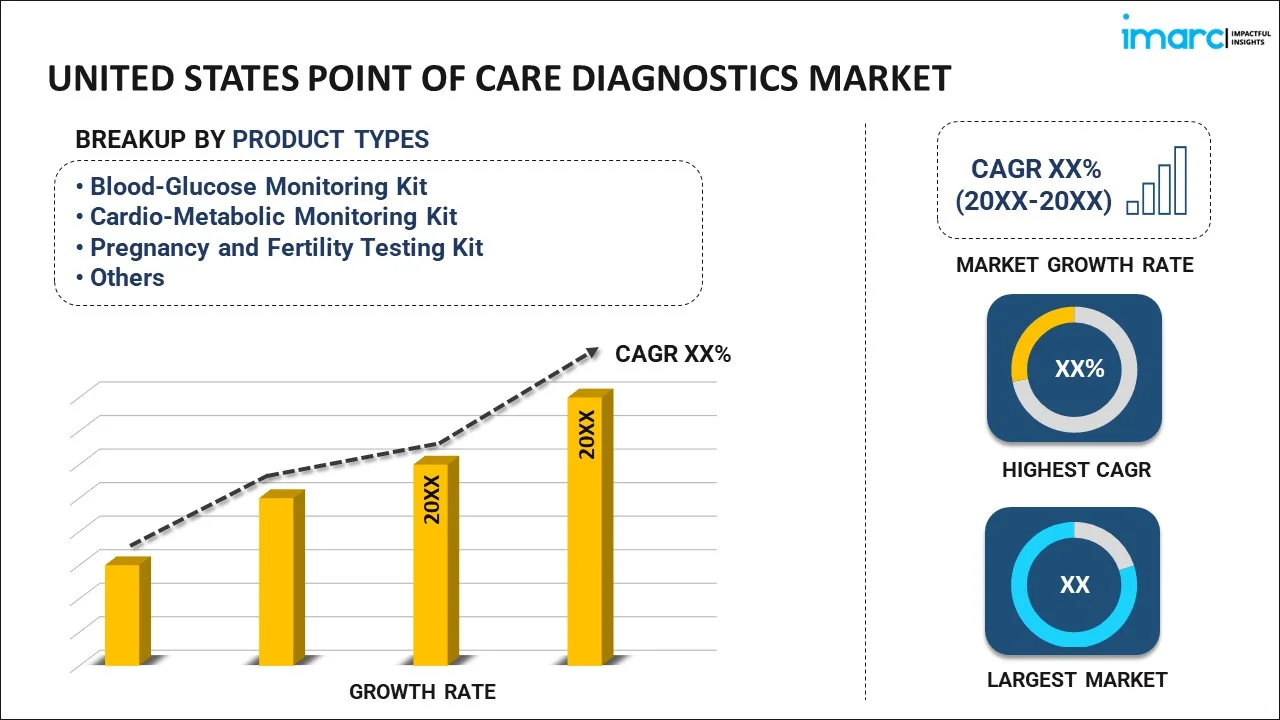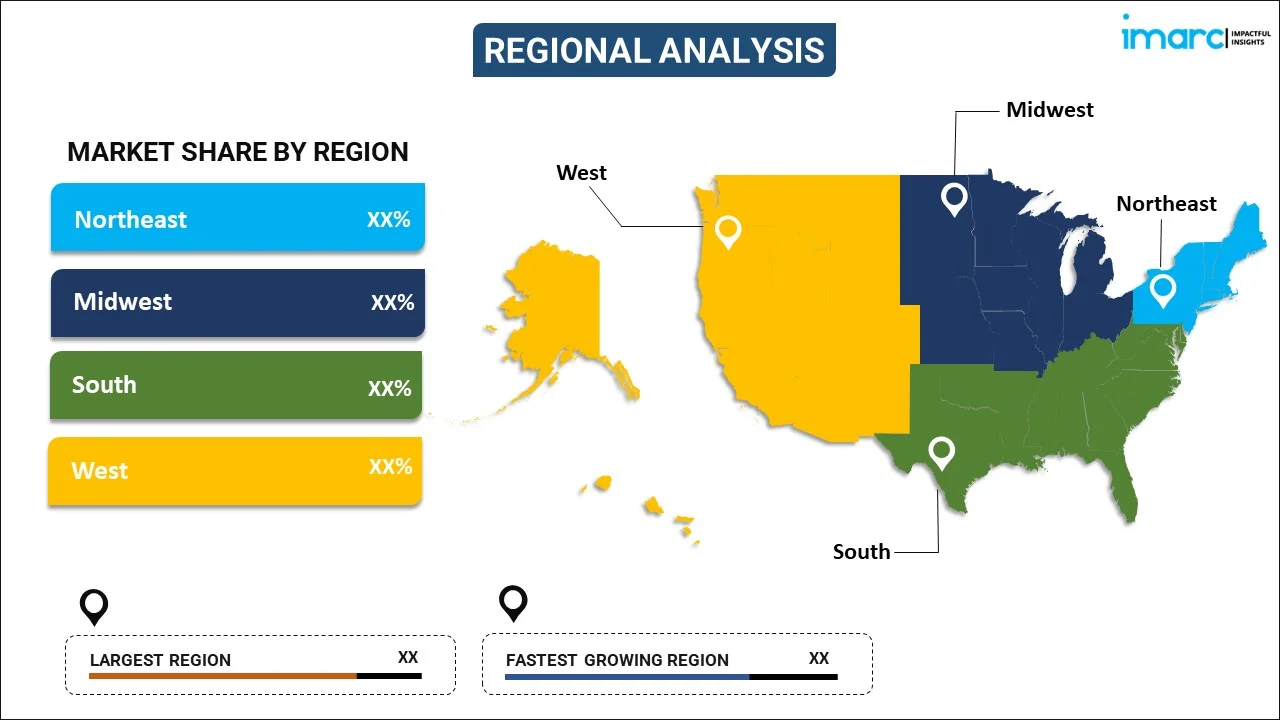
United States Point of Care Diagnostics Market Report by Product Type (Blood-Glucose Monitoring Kit, Cardio-Metabolic Monitoring Kit, Pregnancy and Fertility Testing Kit, Infectious Disease Testing Kit, Cholesterol Test Strip, Hematology Testing Kit, and Others), Platform (Lateral Flow Assays, Dipsticks, Microfluidics, Molecular Diagnostics, Immunoassays), Prescription Mode (Prescription-Based Testing, OTC Testing), End User (Professional Diagnostic Centers, Home Care, Research Laboratories, and Others), and Region 2025-2033
Market Overview:
United States point of care diagnostics market size reached USD 13.1 Billion in 2024. Looking forward, IMARC Group expects the market to reach USD 23.3 Billion by 2033, exhibiting a growth rate (CAGR) of 6.6% during 2025-2033. Numerous advancements in portable and handheld diagnostic devices have enhanced the convenience and user-friendliness of testing, which is primarily driving the market growth.
|
Report Attribute
|
Key Statistics
|
|---|---|
|
Base Year
|
2024
|
|
Forecast Years
|
2025-2033
|
|
Historical Years
|
2019-2024
|
| Market Size in 2024 | USD 13.1 Billion |
| Market Forecast in 2033 | USD 23.3 Billion |
| Market Growth Rate 2025-2033 | 6.6% |
Point-of-care (POC) diagnostics encompass medical examinations and instruments conducted in close proximity to the patient's location, delivering swift results and instant medical insights. Engineered to be straightforward, portable, and user-friendly, these tests empower healthcare professionals to acquire diagnostic information without reliance on a centralized laboratory. The versatility of POC diagnostics is evident in their application across diverse healthcare environments, such as hospitals, clinics, physician offices, homes, and even in remote or resource-constrained areas. The primary objective of point-of-care diagnostics is to expedite timely and precise medical decision-making, particularly in scenarios where rapid test outcomes play a pivotal role in patient management.
United States Point of Care Diagnostics Market Trends:
The United States point-of-care diagnostics market stands as a crucial component of the nation's healthcare infrastructure, playing a vital role in delivering rapid and immediate medical insights to patients. These involve medical tests and devices designed to be performed in close proximity to the patient, eliminating the need for centralized laboratory facilities, which is acting as another significant growth-inducing factor. Moreover, these tests are characterized by their simplicity, portability, and user-friendly nature, enabling healthcare professionals to obtain diagnostic information swiftly and efficiently. Apart from this, the applications of point-of-care diagnostics extend across various healthcare settings, including hospitals, clinics, physician offices, and even reach remote or resource-limited areas, ensuring widespread accessibility. The goal of the U.S. point-of-care diagnostics market is to facilitate timely and accurate medical decision-making, a critical factor in situations where swift test results are essential for effective patient management. With advancements in technology, the market continues to evolve, introducing innovative diagnostic tools that contribute to improved patient outcomes and streamlined healthcare processes. As a result, point-of-care diagnostics in the United States remains integral to enhancing healthcare accessibility, especially in scenarios where immediate diagnostic insights are pivotal for providing efficient and effective medical care. This, in turn, is expected to fuel the regional market over the forecasted period.
United States Point of Care Diagnostics Market Segmentation: -
IMARC Group provides an analysis of the key trends in each segment of the market, along with forecasts at the country level for 2025-2033. Our report has categorized the market based on product type, platform, prescription mode, and end user.
Product Type Insights:

- Blood-Glucose Monitoring Kit
- Cardio-Metabolic Monitoring Kit
- Pregnancy and Fertility Testing Kit
- Infectious Disease Testing Kit
- Cholesterol Test Strip
- Hematology Testing Kit
- Others
The report has provided a detailed breakup and analysis of the market based on the product type. This includes blood-glucose monitoring kit, cardio-metabolic monitoring kit, pregnancy and fertility testing kit, infectious disease testing kit, cholesterol test strip, hematology testing kit, and others.
Platform Insights:
- Lateral Flow Assays
- Dipsticks
- Microfluidics
- Molecular Diagnostics
- Immunoassays
A detailed breakup and analysis of the market based on the platform have also been provided in the report. This includes lateral flow assays, dipsticks, microfluidics, molecular diagnostics, and immunoassays.
Prescription Mode Insights:
- Prescription-Based Testing
- OTC Testing
The report has provided a detailed breakup and analysis of the market based on the prescription mode. This includes prescription-based testing and OTC testing.
End User Insights:
- Professional Diagnostic Centers
- Home Care
- Research Laboratories
- Others
A detailed breakup and analysis of the market based on the end user have also been provided in the report. This includes professional diagnostic centers, home care, research laboratories, and others.
Regional Insights:

- Northeast
- Midwest
- South
- West
The report has also provided a comprehensive analysis of all the major regional markets, which include Northeast, Midwest, South, and West.
Competitive Landscape:
The market research report has also provided a comprehensive analysis of the competitive landscape in the market. Competitive analysis such as market structure, key player positioning, top winning strategies, competitive dashboard, and company evaluation quadrant has been covered in the report. Also, detailed profiles of all major companies have been provided.
United States Point of Care Diagnostics Market Report Coverage:
| Report Features | Details |
|---|---|
| Base Year of the Analysis | 2024 |
| Historical Period | 2019-2024 |
| Forecast Period | 2025-2033 |
| Units | Billion USD |
| Scope of the Report | Exploration of Historical Trends and Market Outlook, Industry Catalysts and Challenges, Segment-Wise Historical and Future Market Assessment:
|
| Product Types Covered | Blood-Glucose Monitoring Kit, Cardio-Metabolic Monitoring Kit, Pregnancy and Fertility Testing Kit, Infectious Disease Testing Kit, Cholesterol Test Strip, Hematology Testing Kit, Others |
| Platforms Covered | Lateral Flow Assays, Dipsticks, Microfluidics, Molecular Diagnostics, Immunoassays |
| Prescription Modes Covered | Prescription-Based Testing, OTC Testing |
| End Users Covered | Professional Diagnostic Centers, Home Care, Research Laboratories, Others |
| Regions Covered | Northeast, Midwest, South, West |
| Customization Scope | 10% Free Customization |
| Post-Sale Analyst Support | 10-12 Weeks |
| Delivery Format | PDF and Excel through Email (We can also provide the editable version of the report in PPT/Word format on special request) |
Key Questions Answered in This Report:
- How has the United States point of care diagnostics market performed so far and how will it perform in the coming years?
- What has been the impact of COVID-19 on the United States point of care diagnostics market?
- What is the breakup of the United States point of care diagnostics market on the basis of product type?
- What is the breakup of the United States point of care diagnostics market on the basis of platform?
- What is the breakup of the United States point of care diagnostics market on the basis of prescription mode?
- What is the breakup of the United States point of care diagnostics market on the basis of end user?
- What are the various stages in the value chain of the United States point of care diagnostics market?
- What are the key driving factors and challenges in the United States point of care diagnostics?
- What is the structure of the United States point of care diagnostics market and who are the key players?
- What is the degree of competition in the United States point of care diagnostics market?
Key Benefits for Stakeholders:
- IMARC’s industry report offers a comprehensive quantitative analysis of various market segments, historical and current market trends, market forecasts, and dynamics of the United States point of care diagnostics market from 2019-2033.
- The research report provides the latest information on the market drivers, challenges, and opportunities in the United States point of care diagnostics market.
- Porter's five forces analysis assist stakeholders in assessing the impact of new entrants, competitive rivalry, supplier power, buyer power, and the threat of substitution. It helps stakeholders to analyze the level of competition within the United States point of care diagnostics industry and its attractiveness.
- Competitive landscape allows stakeholders to understand their competitive environment and provides an insight into the current positions of key players in the market.
Need more help?
- Speak to our experienced analysts for insights on the current market scenarios.
- Include additional segments and countries to customize the report as per your requirement.
- Gain an unparalleled competitive advantage in your domain by understanding how to utilize the report and positively impacting your operations and revenue.
- For further assistance, please connect with our analysts.
 Inquire Before Buying
Inquire Before Buying
 Speak to an Analyst
Speak to an Analyst
 Request Brochure
Request Brochure
 Request Customization
Request Customization




.webp)




.webp)












